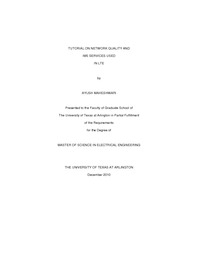| dc.description.abstract | 3rd Generation or 3G technologies like WCDMA, HSPA and GPRS are very advanced technologies in themselves. They allow data downlink speeds of up to 7Mbps and will soon be offering up to 14Mbps. The number of people using these networks has crossed 70 million users worldwide and with ever increasing users we need to provide a solution to handle the new and improved services which are being designed daily to work on mobile devices. Long Term Evolution (LTE), will be one of the two technologies which will meet the ITU's IMT-Advanced requirements for 4G technologies. 3G Partnership Project (3GPP) is the organization behind the design and development of LTE. The design parameters for LTE included a system with higher data rates, low latency and high spectral efficiency. The design that was developed is said to have four times better performance figures than the previous technologies. To achieve these high numbers, LTE is based on Multiple Input Multiple Output (MIMO) antenna technique, inter-cell interference mitigation, low latency structure, Single-Carrier Frequency Division Multiple Access (SC-FDMA) and Single-Frequency Network (SFN) Broadcast.In this research documents, we have paid close attention on how services like voice and MBMS have been brought to the users in LTE. Since LTE will be replacing the current telecommunication network, it is very important to see that Voice over LTE (VoLTE) gives better results when comparing with the current telecommunication networks. Also, the high data rates allow many MBMS services to be streamed to the user. LTE also has inherent support for relay systems. In previous technologies, even with high data speeds and good coverage, the users at the cell edge suffered from poor service overall. We have analyzed the conditions that a UE will face when dealing with the new relay architectures. | en_US |

